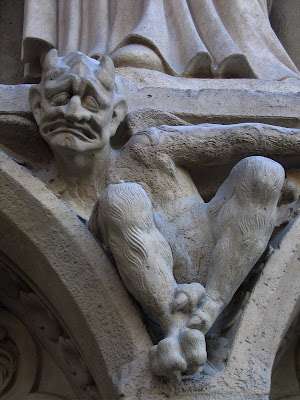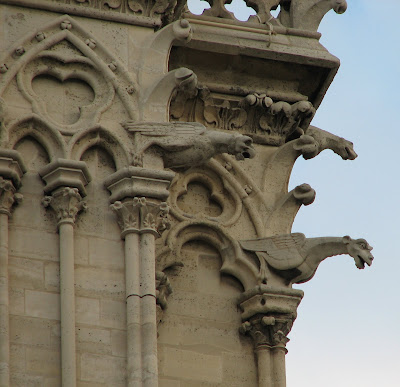
Στην αρχιτεκτονική τα Gargoyles (κρουνοί) είναι λαξεμένες πέτρινες αποτρόπαιες μορφές (Γκροτέσκα ή Χίμαιρες) που απλώς απάγουν το βρόχινο νερό από τις σκεπές παλιών σπιτιών ή καθεδρικών ναών ρίχνοντάς το στο έδαφος (υδρορροές). Οι αποτρόπαιες μορφές, συνήθως δαιμόνων, δράκων, ξωτικών ή ζώων δίνονταν για να προκαλέσουν το φόβο και να απωθήσουν κάθε κακόβουλο πνεύμα ή δαίμονα από το οίκημα. Αλλά τέτοιες μορφές δεν είναι απαραίτητα να αποτελούν κρουνούς, μπορεί να αποτελούν μέρος της διακόσμησης του κτίσματος, οπότε ονομάζονται Αποτρόπαια ή Χίμαιρες (grotesques, chimeras)

Στην αρχαία Αίγυπτο και την Ελλάδα πολλοί ναοί είχαν τέτοιους πέτρινους κρουνούς με μορφές ζώων, κυρίως λιονταριών ή και σάτυρων (Αρχαία Ελλάδα). Στην Ευρώπη πολλοί καθεδρικοί ναοί είναι γνωστοί για αυτές τις αποτρόπαιες μορφές (είτε κρουνοί είτε αποτρόπαια), με πιο γνωστή την Παναγία των Παρισίων. Στις εκκλησίες ο ρόλος τους πιστεύεται ότι ήταν , είτε για να εμπνεύσουν φόβο στους πιστούς και να πηγαίνουν εκκλησία, ότι δήθεν το κακό παραμονεύει και το τέλος του κόσμου είναι κοντά, είτε ως απωθητικά του κακού που παραμένουν έξω από την εκκλησία.

Το όνομα Gargoyle είναι λατινογενές και έχει σχέση με λαιμό, ροή και σχετικό ήχο νερού. Υπάρχει και ένας θρύλος για ένα δράκο του Σηκουάνα που εκτόξευε νερό και τρομοκρατούσε τους βαρκάρηδες που ονομάζονταν Gargouille και όταν το σκότωσαν το κεφάλι του εντοιχίστηκε σε μια εκκλησία, από όπου έτρεχε το νερό της βροχής. Πιστεύεται πως δεν υπάρχει άμεση συσχέτιση των ονομάτων τους παρά μόνο από το κοινό τους γνώρισμα, της ροής νερού.

In architecture, a gargoyle is a carved stone grotesque with a spout designed to convey water from a roof and away from the side of a building. A grotesque figure of chimera , also known as gargoyle is a sculpture that does not work as a waterspout and serves only an ornamental or artistic function, although the field of architecture usually preserves the distinction between gargoyles (functional waterspouts) and non-waterspout grotesques. Gargoyles are said to scare off and protect from any evil or harmful spirits.

The term gargoyle is most often applied to medieval work, but throughout all ages some means of water diversion, when not conveyed in gutters, was adopted. In Ancient Egyptian architecture, gargoyles showed little variation, typically in the form of a lion's head. Similar lion or satyr mouthed water spouts were also seen on Ancient Greek temples.

Many medieval cathedrals included gargoyles and chimeras. The most famous examples are those of Notre Dame de Paris. Although most have grotesque features, the term gargoyle has come to include all types of images. Some gargoyles were depicted as monks, or combinations of real animals and people, many of which were humorous. Unusual animal mixtures, or chimeras, did not act as rainspouts and are more properly called grotesques. They serve more as ornamentation, but are now synonymous with gargoyles.

Gargoyles were viewed in two ways by the church throughout history. Often gargoyles were used to assist the Church in conveying messages to the common people. Since literacy was uncommon, images were the best way to constantly convey ideas. Gargoyles were used as a representation of evil. It is thought that they were used to scare people into coming to church, reminding them that the end of days is near. It is also thought that their presence assured congregants that evil is kept outside of the church’s walls. According to Lester Burbank Bridham, writing in Gargoylaes, Chimeres and the Grotesque in French Gothic Sculpture, "There is much symbolism in the sculpture of [the Gothic] period; but we must be wary of reading in too much meaning."

The term originates from the French gargouille, originally "throat" or "gullet" from Latin gurgulio, gula, gargula ("gullet" or "throat") and similar words derived from the root gar, "to swallow", which represented the gurgling sound of water.

The Gargouille, was allegedly a serpent-like water-spouting dragon that appeared in the Seine River in France. It was said to terrorize boats and flood the land. In legend, Saint Romain, the archbishop of Rouen, lured the monster to shore using a convict, and then made a cross with his fingers to tame the monster. He then led it into town where it was slaughtered. Some accounts say it was burned. The accounts of burning say that neither the monster's head or neck would burn, so they were mounted on the town's cathedral to display God's power.

The creature was then said to have been carved onto buildings to be used as water drainage, therefore creating the modern gargoyle. It is similarly accounted that they have no relation other than their water-spouting abilities, leading to the words' similarities (the word gargouille is used for both in french, though) (
Wikipedia)
 Thomas Rowlandson (1756 – 1827) was an English artist and caricaturist. Dance of Death, issued in 1814–16, was one of the most admirable of Rowlandson’s series. They were inspired from Holbein's danse macabre motif with a poetic text under each image, in a cartunistic satirical sense, presenting Death's power over people in a cynic way with or without moral lesson or instructions.
Thomas Rowlandson (1756 – 1827) was an English artist and caricaturist. Dance of Death, issued in 1814–16, was one of the most admirable of Rowlandson’s series. They were inspired from Holbein's danse macabre motif with a poetic text under each image, in a cartunistic satirical sense, presenting Death's power over people in a cynic way with or without moral lesson or instructions. He also produced a body of erotic prints and woodcuts, many of which would be considered pornographic today. He dealt less frequently with politics, but commonly touching, in a rather gentle spirit, the various aspects and incidents of social life. You can see all of his Danse Macabre series HERE and HERE
He also produced a body of erotic prints and woodcuts, many of which would be considered pornographic today. He dealt less frequently with politics, but commonly touching, in a rather gentle spirit, the various aspects and incidents of social life. You can see all of his Danse Macabre series HERE and HERE










































































.jpg)



